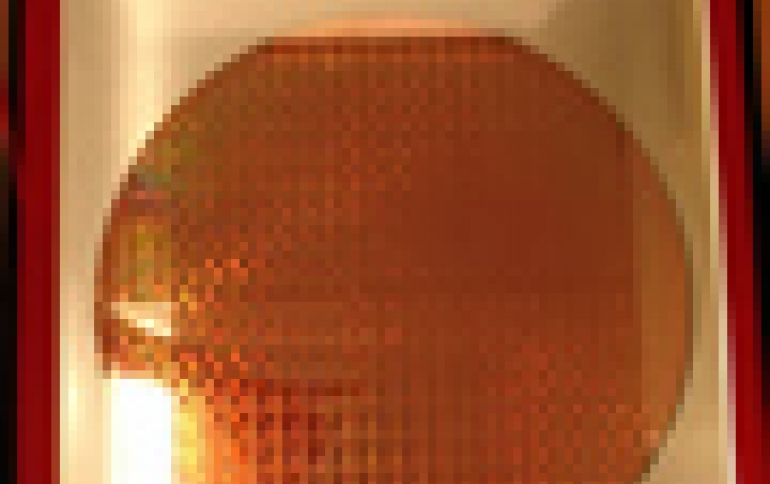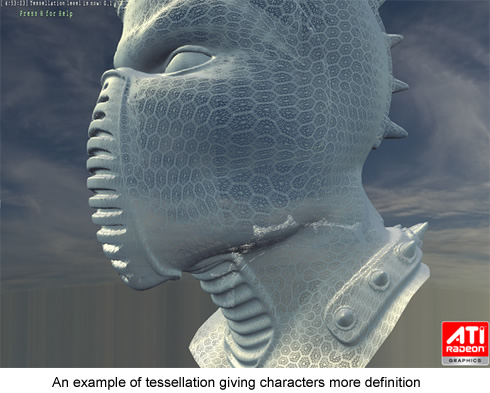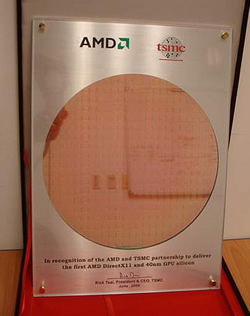
AMD Demonstrates First Microsoft DirectX 11 Graphics Processor
At a press conference in Taipei, Taiwan, AMD publicly demonstrated the world?s first Microsoft DirectX 11 graphics processor.
The series of demonstrations shed new light on the significantly improved computing experience set to debut at the end of 2009.
To illustrate, AMD showed numerous examples of faster application performance and new game features using the world?s first DirectX 11 graphics processor.
DirectX 11 features such as tessellation will bring consumers higher quality, superior performing games.
There are three main areas of impact in DirectX 11:
A beast called the tessellator has been added which enables games developers to create smoother, less blocky and more organic looking objects in games. This is the change users will probably be most aware of. And it?ll show up when someone is looking at the silhouettes of hills and mountains or the profiles of characters in games. Where artists previously had to trade off quality for performance, now artists will have the freedom to create naturalistic scenery. The tessellator represents a natural next step in gaming hardware (in fact the Xbox 360 graphics chip that AMD designed already has a tessellator, and AMD graphics hardware has featured tessellator technology starting with the ATI Radeon HD 2000 series right up to the latest ATI Radeon HD 4000 series cards today).

Games programmers will also be given a radically new way to program for AMD graphics chips. The second new beast in the menagerie is the excitingly named "Compute Shader". It allows games programmers to treat the GPU in a much less graphics-oriented way; indeed, they can almost treat it like a highly parallel CPU.
Up until DirectX 10.1 a graphics programmer always had to think in terms of triangles - but the compute shader changes that and allows the programmer a much freer expression of their thoughts. The compute shader is a more natural way for the programmer to approach his or her task. On top of that it allows access to some of the features that would otherwise have been hidden away inside our present and future chips and for that reason it will often allow significantly more efficient implementations than heretofore (that means "higher frame rates").
 Finally the DirectX has been sliced and diced and the internals redesigned to ensure that it is much more efficient at using the horsepower present in multiple CPU cores. It will provide the opportunity for both higher frame rates and games which are more realistic, because they contain more detail.
Finally the DirectX has been sliced and diced and the internals redesigned to ensure that it is much more efficient at using the horsepower present in multiple CPU cores. It will provide the opportunity for both higher frame rates and games which are more realistic, because they contain more detail.
There are numerous other, less important changes aimed to make the games programmer?s tasks easier. Some so small that users would have to be a games programmer to care, some (like improved texture compression) are big enough to help out significantly with performance in corner cases.
Quite often you get to hear rather bland but optimistic statements about the future versions of DirectX. "It?ll be faster and better" - but you don?t get to hear much in the way of substantial justification.
Richard Huddy is Sr. Manager Developer Relations at AMD predicts that we?ll see higher frame rates because the way DirectX 11 uses CPUs will be more efficient and games developers will be able to use GPUs more like CPUs. He also says that we?ll see smoother, more realistic characters and more realistic terrain as we move away from blocky polygonal representations to the kind that are used in movies.
A side-benefit, that will help PC gaming generally, is that the new version is easier to use, so it will help to keep game development costs down.
DirectX 10.1 is the currently the closest someone can get to DirectX 11 until Windows 7 ships. The compute shader, will enable AMD?s DirectX 11 graphics cards to help make Windows 7 run faster in a wide number of applications and in a manner that?s completely transparent to users, for example, in seamlessly accelerating the conversion of video for playback on portable media players through a drag-and-drop interface.
AMD said that its many of the capabilities of DirectX 11 were pioneered on AMD GPUs, including DirectX 10.1, tessellation, compute shaders, Fetch4, custom filter anti-aliasing and high-definition ambient occlusion shading.
"AMD has a long track record of delivering pioneering features that have gone on to become mainstays in the DirectX experience, and we?re doing it again with two mature, AMD-developed technologies in DirectX 11 ? tessellation and the compute shader ? both of which enable a better DirectX 11 experience for consumers," said Rick Bergman, Senior Vice President, AMD Products Group. "Today, we?re previewing AMD?s DirectX 11 graphics processor to build enthusiasm for this key technology so developers will have games available at launch and shortly thereafter. With the benefits it delivers to gaming, applications and Windows 7, developers are lining up to get their hands on our hardware, and we?re confident that consumers will too."
To illustrate, AMD showed numerous examples of faster application performance and new game features using the world?s first DirectX 11 graphics processor.
DirectX 11 features such as tessellation will bring consumers higher quality, superior performing games.
There are three main areas of impact in DirectX 11:
A beast called the tessellator has been added which enables games developers to create smoother, less blocky and more organic looking objects in games. This is the change users will probably be most aware of. And it?ll show up when someone is looking at the silhouettes of hills and mountains or the profiles of characters in games. Where artists previously had to trade off quality for performance, now artists will have the freedom to create naturalistic scenery. The tessellator represents a natural next step in gaming hardware (in fact the Xbox 360 graphics chip that AMD designed already has a tessellator, and AMD graphics hardware has featured tessellator technology starting with the ATI Radeon HD 2000 series right up to the latest ATI Radeon HD 4000 series cards today).

Games programmers will also be given a radically new way to program for AMD graphics chips. The second new beast in the menagerie is the excitingly named "Compute Shader". It allows games programmers to treat the GPU in a much less graphics-oriented way; indeed, they can almost treat it like a highly parallel CPU.
Up until DirectX 10.1 a graphics programmer always had to think in terms of triangles - but the compute shader changes that and allows the programmer a much freer expression of their thoughts. The compute shader is a more natural way for the programmer to approach his or her task. On top of that it allows access to some of the features that would otherwise have been hidden away inside our present and future chips and for that reason it will often allow significantly more efficient implementations than heretofore (that means "higher frame rates").
 Finally the DirectX has been sliced and diced and the internals redesigned to ensure that it is much more efficient at using the horsepower present in multiple CPU cores. It will provide the opportunity for both higher frame rates and games which are more realistic, because they contain more detail.
Finally the DirectX has been sliced and diced and the internals redesigned to ensure that it is much more efficient at using the horsepower present in multiple CPU cores. It will provide the opportunity for both higher frame rates and games which are more realistic, because they contain more detail.
There are numerous other, less important changes aimed to make the games programmer?s tasks easier. Some so small that users would have to be a games programmer to care, some (like improved texture compression) are big enough to help out significantly with performance in corner cases.
Quite often you get to hear rather bland but optimistic statements about the future versions of DirectX. "It?ll be faster and better" - but you don?t get to hear much in the way of substantial justification.
Richard Huddy is Sr. Manager Developer Relations at AMD predicts that we?ll see higher frame rates because the way DirectX 11 uses CPUs will be more efficient and games developers will be able to use GPUs more like CPUs. He also says that we?ll see smoother, more realistic characters and more realistic terrain as we move away from blocky polygonal representations to the kind that are used in movies.
A side-benefit, that will help PC gaming generally, is that the new version is easier to use, so it will help to keep game development costs down.
DirectX 10.1 is the currently the closest someone can get to DirectX 11 until Windows 7 ships. The compute shader, will enable AMD?s DirectX 11 graphics cards to help make Windows 7 run faster in a wide number of applications and in a manner that?s completely transparent to users, for example, in seamlessly accelerating the conversion of video for playback on portable media players through a drag-and-drop interface.
AMD said that its many of the capabilities of DirectX 11 were pioneered on AMD GPUs, including DirectX 10.1, tessellation, compute shaders, Fetch4, custom filter anti-aliasing and high-definition ambient occlusion shading.
"AMD has a long track record of delivering pioneering features that have gone on to become mainstays in the DirectX experience, and we?re doing it again with two mature, AMD-developed technologies in DirectX 11 ? tessellation and the compute shader ? both of which enable a better DirectX 11 experience for consumers," said Rick Bergman, Senior Vice President, AMD Products Group. "Today, we?re previewing AMD?s DirectX 11 graphics processor to build enthusiasm for this key technology so developers will have games available at launch and shortly thereafter. With the benefits it delivers to gaming, applications and Windows 7, developers are lining up to get their hands on our hardware, and we?re confident that consumers will too."





















